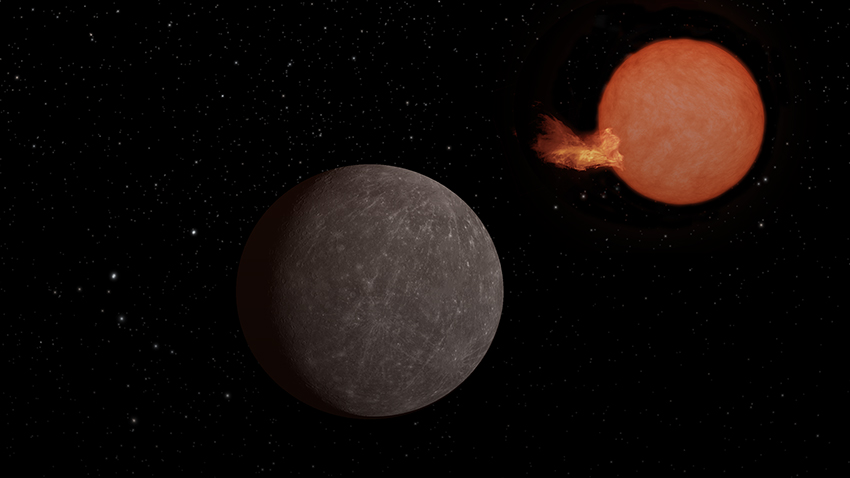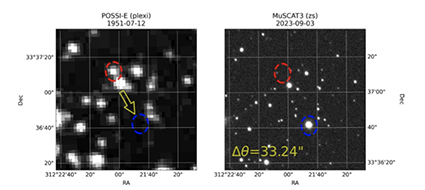Hot and Cold: an Exo-Earth and Its Ultracool Star
May 15, 2024

An international team of astronomers, including members of UC San Diego’s Cool Star Lab, have announced the rare discovery of an Earth-sized planet, named SPECULOOS-3 b, orbiting a small, dim “ultracool dwarf star.”
It is only the second planetary system discovered around this type of star, following the famous TRAPPIST-1 system discovered in 2017. However, the new terrestrial world is not likely to be a habitable — it is close enough to its star that its dayside surface temperature is hotter than that of Venus.
Their findings appear in a recent issue of Nature Astronomy.
A hot exoplanet and its cold host star
The SPECULOOS-3 b exoplanet is about 55 light-years from our solar system. It is nearly the same size as Earth, but a year on SPECULOOS-3 b lasts a mere 17 hours. Days and nights, on the other hand, may never end: the planet is thought to rotate synchronously with its orbit so that the same side of the planet faces the same side to the star, just as the Moon does for the Earth. This means the night side is locked in endless darkness.
The SPECULOOS-3 star is an example of an ultracool dwarf. Similar in size to Jupiter, they are more than twice as cold, ten times less massive, and a hundred times less luminous than our Sun. Because they fuse hydrogen more slowly, their lifespans are over a hundred times longer than that of the Sun, and they will be the last stars to shine when the universe becomes cold and dark.
“Ultracool dwarf stars are the overlooked majority in the Milky Way,” said Professor of Astronomy and Astrophysics Adam Burgasser, who is coauthor on the study and director of the Cool Star Lab. “They are by far the most common star in the Milky Way, but are so cold and dim that even the nearest ultracool dwarf is invisible to the naked eye, making them harder to detect. They are still a poorly understood population.”
Burgasser worked with recent Ph.D. graduates Christian Aganze and Roman Gerasimov, who conducted analysis of the star using facilities at the Lick Observatory in San Jose, California.

An image taken in 1951 (l) and 2023 (r) show the previous (blue) and current (red) of SPECULOOS-3 b.
While SPECULOOS-3’s star is more than twice as cold as the Sun, with an average temperature of around 2,600°C (4,700 ºF), the planet’s extremely short orbit means it receives nearly 16 times more energy than the Earth does from the Sun. It is also bombarded with high-energy radiation, such as UV and X-ray light, from the star’s magnetic flares.
“In such an environment, the presence of an atmosphere around the planet is highly unlikely,” says Julien de Wit, a professor at MIT and co-director of the SPECULOOS Northern Observatory. “The fact that this planet has no atmosphere could be a plus in several respects. It could enable us to learn a great deal about ultracool dwarf stars, which in turn will make possible more in-depth studies of their potentially habitable planets.”
While it may be too hot for life as we know it, SPECULOOS-3 b is an excellent target for the James Webb Space Telescope (JWST). Launched in 2021, JWST data are revolutionizing our understanding of the universe. Because it so close to its star, SPECULOOS-3 b reflects a significant amount of light from it dayside surface, which could be inferred as the planet passes behind its star. JWST could help astronomers study the mineralogy of the planet's surface.
"This discovery demonstrates the ability of SPECULOOS to detect Earth-sized exoplanets that lend themselves well to detailed studies. This is just the beginning," concluded Michaël Gillon, the paper’s lead author.
About SPECULOOS
The SPECULOOS (Search for Planets EClipsing ULtra-cOOl Stars) project is directed by Michaël Gillon of the University of Liège, and is specially designed to search for exoplanets around the nearest ultracool dwarf stars. Scattered across the sky, they need to be observed one by one, over a period of weeks, to detect rare transiting planets. The discoveries are made possible by a dedicated network of robotic telescopes in Chile, Mexico and the Canary Islands, jointly run by the Universities of Liège, University of Cambridge, University of Birmingham, University of Berne, MIT and ETH Zürich.
